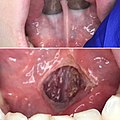Lingual frenectomy
Lingual Frenectomy is a surgical procedure performed to correct a condition known as Ankyloglossia, or tongue-tie. This condition is characterized by an unusually short, thick, or tight band of tissue (the lingual frenulum) tethering the bottom of the tongue's tip to the floor of the mouth.
Procedure[edit]
The procedure involves the removal or alteration of the lingual frenulum. This can be done using a number of different techniques, including traditional surgery, laser surgery, or a frenotomy. The choice of technique depends on the specific needs of the patient and the judgement of the healthcare provider.
Traditional Surgery[edit]
In a traditional lingual frenectomy, a surgeon will use a scalpel to cut the frenulum. The wound is then stitched up to heal.
Laser Surgery[edit]
In a laser lingual frenectomy, a laser is used to cut the frenulum. The laser cauterizes the wound as it cuts, reducing bleeding and often eliminating the need for stitches.
Frenotomy[edit]
A frenotomy is a less invasive procedure that can be used in some cases. It involves making a small cut in the frenulum to loosen it and allow the tongue more freedom of movement.
Indications[edit]
A lingual frenectomy may be indicated for a number of reasons. These can include difficulty with speech, difficulty with eating or swallowing, or issues with oral hygiene due to the inability to properly clean the area under the tongue. In infants, a tongue-tie can cause problems with breastfeeding.
Risks and Complications[edit]
As with any surgical procedure, a lingual frenectomy carries some risks. These can include infection, bleeding, damage to the tongue or other oral structures, and complications related to anesthesia. There may also be changes in speech or sensation in the tongue following the procedure.
Recovery[edit]
Recovery from a lingual frenectomy generally involves a period of healing and may include exercises to improve tongue mobility and flexibility. Pain and swelling are common in the first few days after the procedure, but these symptoms usually resolve within a week.
See Also[edit]
Ad. Transform your life with W8MD's Budget GLP-1 injections from $75


W8MD offers a medical weight loss program to lose weight in Philadelphia. Our physician-supervised medical weight loss provides:
- Weight loss injections in NYC (generic and brand names):
- Zepbound / Mounjaro, Wegovy / Ozempic, Saxenda
- Most insurances accepted or discounted self-pay rates. We will obtain insurance prior authorizations if needed.
- Generic GLP1 weight loss injections from $75 for the starting dose.
- Also offer prescription weight loss medications including Phentermine, Qsymia, Diethylpropion, Contrave etc.
NYC weight loss doctor appointmentsNYC weight loss doctor appointments
Start your NYC weight loss journey today at our NYC medical weight loss and Philadelphia medical weight loss clinics.
- Call 718-946-5500 to lose weight in NYC or for medical weight loss in Philadelphia 215-676-2334.
- Tags:NYC medical weight loss, Philadelphia lose weight Zepbound NYC, Budget GLP1 weight loss injections, Wegovy Philadelphia, Wegovy NYC, Philadelphia medical weight loss, Brookly weight loss and Wegovy NYC
|
WikiMD's Wellness Encyclopedia |
| Let Food Be Thy Medicine Medicine Thy Food - Hippocrates |
Medical Disclaimer: WikiMD is not a substitute for professional medical advice. The information on WikiMD is provided as an information resource only, may be incorrect, outdated or misleading, and is not to be used or relied on for any diagnostic or treatment purposes. Please consult your health care provider before making any healthcare decisions or for guidance about a specific medical condition. WikiMD expressly disclaims responsibility, and shall have no liability, for any damages, loss, injury, or liability whatsoever suffered as a result of your reliance on the information contained in this site. By visiting this site you agree to the foregoing terms and conditions, which may from time to time be changed or supplemented by WikiMD. If you do not agree to the foregoing terms and conditions, you should not enter or use this site. See full disclaimer.
Credits:Most images are courtesy of Wikimedia commons, and templates, categories Wikipedia, licensed under CC BY SA or similar.
Translate this page: - East Asian
中文,
日本,
한국어,
South Asian
हिन्दी,
தமிழ்,
తెలుగు,
Urdu,
ಕನ್ನಡ,
Southeast Asian
Indonesian,
Vietnamese,
Thai,
မြန်မာဘာသာ,
বাংলা
European
español,
Deutsch,
français,
Greek,
português do Brasil,
polski,
română,
русский,
Nederlands,
norsk,
svenska,
suomi,
Italian
Middle Eastern & African
عربى,
Turkish,
Persian,
Hebrew,
Afrikaans,
isiZulu,
Kiswahili,
Other
Bulgarian,
Hungarian,
Czech,
Swedish,
മലയാളം,
मराठी,
ਪੰਜਾਬੀ,
ગુજરાતી,
Portuguese,
Ukrainian



